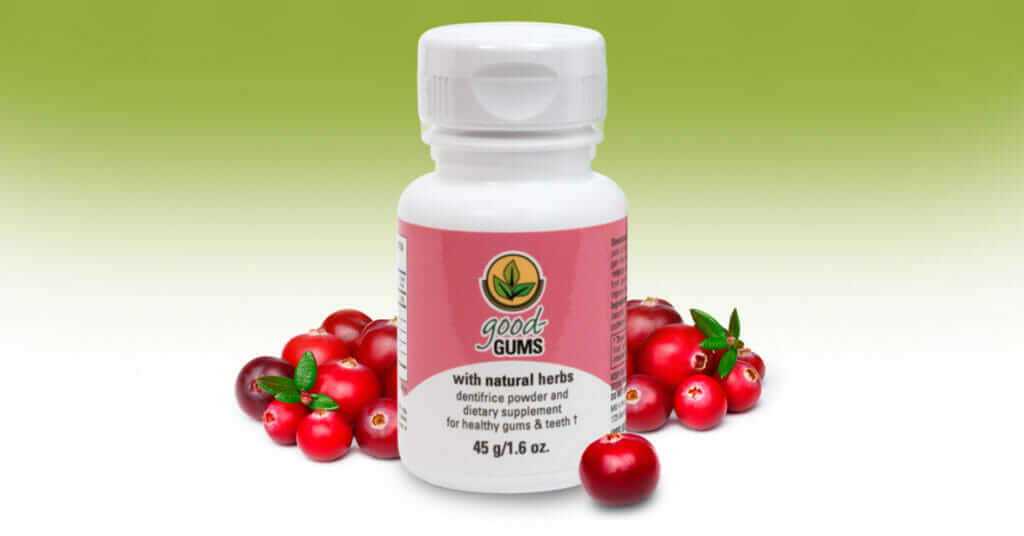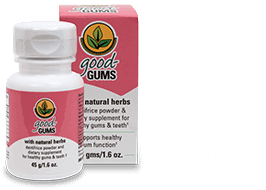Have you been told by your dentist that you need to see a periodontist due to loss of gum tissue? Are you scared of learning how bad it is, what procedure you’ll have to go through, and how much it will cost? Are you feeling torn between wanting to get your problem fixed, and doubting that the pain, time-inconvenience and expense will really be a permanent solution to the problem?
You’re not alone, periodontitis affects millions people, even those conscientious about their oral health.
Don’t worry! Good-Gums is here to help!
The scientifically backed ingredients in Good-Gums are specifically designed to support your body’s natural tendency to heal itself. Many people who have used Good-Gums have found that their condition has improved, and in some cases have even made their trip to the periodontist unnecessary. There’s cause for hope that there is a much cheaper, less painful option to try before resorting to expensive and intrusive procedures, and you’ll feel more knowledgeable and in control of your oral health.
Karen FI want to tell you how much I appreciate your product. It’s kept me away from the periodontist. They were getting ready to send me to one. Now my gums are pink and healthy. It’s wonderful.*

What does it mean to have periodontitis?
If your dentist told you to make an appointment with a periodontist, then some of the tissue that supports at least some of your teeth have probably already been lost, and the current conditions of your mouth are conducive to further destruction of additional tissue unless something changes. The current conditions fall under the classification of periodontal disease, which means disease of the tissue around the tooth. If allowed to progress, it eventually leads to loss of teeth.
It helps to understand a little about how teeth are attached. A jawbone with tooth sockets (alveolar bone) is not connected directly to the roots of the teeth but instead via thousands of tiny fibers called periodontal ligaments between the bone and the cementum that covers a tooth’s root. This arrangement allows for a way to sense the amount of biting pressure (when the ligaments are stretched) and allows for a tiny amount of “shock-absorber” effect. Some of the tooth root closer to the crown of a tooth and beyond the crest of the jawbone is attached to the gums via gingival fibers.
In periodontal disease, infection destroys some of the tissue that connects a tooth to the gums and a tooth to its jawbone (clinical attachment loss). That could include destruction of periodontal ligaments, progressive bone loss, exposed roots or looseness and movement of teeth. The infection can become too deep to be addressed by normal oral hygiene, such as tooth brushing, flossing or even normal cleaning by a dental hygienist (oral prophylaxis). That’s when a dentist recommends a periodontist.
What a periodontist typically does is remove the infecting bacteria as deep as it has penetrated. Deep scaling is a procedure to remove tartar (plaque that has absorbed saliva-minerals to form a calcification) from the tooth root below the gum line, and an associated procedure is root planning, to smooth the surface of the root so that plaque and tartar can’t so easily adhere. A smooth surface also increases the chances of tissue re-growth to restore some of the tooth’s attachment. Periodontal flap surgery is a procedure to temporarily cut and peel back gum tissue to give access to the infected area that’s too deep to reach from the surface. In extreme cases, where there has been too much bone loss, a periodontist may implant a piece of bone (typically sourced from a cadaver) into an area of the jawbone. When the loss of teeth is inevitable, a periodontist may implant metal posts into the jawbone on which artificial teeth are mounted (dental implants); careful oral hygiene is still required to prevent any future bone loss which would cause the implants’ posts to come loose and the implanted teeth to be lost.
Let’s see how Good-Gums can help!
Astara SI want to thank you for creating Good Gums. A friend told me about your product when I needed most to bring in a natural solution to my dental health. I was given a rather unsettling report and sent to a periodontal dentist. I used your product for 2 months before seeing him and the pockets were so reduced there was no talk of scraping or tooth loss. I am thrilled with the results and plan to continue to use Good-Gums! I have recommended this product to my brother and a friend since getting my clean bill of health from the periodontist! Thank you so much!!*
How our combination of scientifically backed ingredients help:
Good-Gums is particularly formulated to help the gums. It works with your body’s natural processes, whose predisposition is to heal and nurture. Good-Gums takes advantage of two facts about your gums: their cells have some of the fastest replacement rates in your body, and they are comprised almost entirely of connective tissue. In most of the body a cell lives for an average of 7 to 10 years before being replaced, while a new gum cell is replaced after only 5 to 7 to 14 days. Healthier gum cells can start replacing less-healthy cells quickly, if they are given what they need. What new gum cells need is what all connective tissue cells absolutely rely on for their formation: a large amount of vitamin C. Good-Gums is unique in providing a healthy amount of vitamin C, plus citrus bioflavonoids that help the body utilize the vitamin C. Check the labels: other products (whether pastes. balms or essential oils) just don’t provide it.
The Good-Gums formula dissolves right in the mouth to be absorbed directly by the gums, where it’s needed the most. The Good-Gums formula also contains a lot of alkaline baking soda to buffer the acidity of its vitamin C, thereby protecting your enamel from acid erosion. To keep the alkaline baking soda from reacting with the acidic vitamin C in the bottle, the entire formula is kept in a dry powder state. When the powder meets saliva in your mouth, it becomes a liquid solution that starts getting absorbed by the gums immediately, before the two ingredients (alkaline and acidic) could react or could to weaken the vitamin C.

Good-Gums encourages absorption by the inclusion of French grey sea salt, with a mineral balance similar to human-produced fluids (so much so that it was successfully used in place of blood for transfusions to some wounded sailors in WW-II, when blood wasn’t available). This matching mineral composition avoids an ion imbalance that would otherwise stop absorption through cell membranes. Since more of the Good-Gums solution can be absorbed, it can do its work quicker and better.
Besides supporting the growth of healthier new gum cells, Good-Gums also has herbal ingredients that soothe sore gums. Myrrh and peppermint are famous for their soothing properties. Cinnamon is a potent anti-inflammatory. And salt solutions are so soothing as to be the standard recommendation by dentists after oral surgery. All are carefully-selected ingredients of Good-Gums.
To help control the population of the plaque-producing bacteria, peppermint, myrrh, and cinnamon act as, natural antimicrobials. Baking soda, besides buffering the acidity of vitamin C, also makes the oral environment less favorable for the proliferation of acid-loving, plaque-producing bacteria.
To help remove plaque from constant contact with the gum margins (where they can re-infect the gums), Good-Gums employs the extraordinary property of cranberry, which significantly loosens the grip of plaque bacteria on the nanoscale, so that it the plaque bacteria can more easily be removed by the mechanical action of toothbrush bristles and floss. Your gums can improve by the combination of these three strategies: by our unique active nutritional support for the formation of healthier new gum cells, by soothing sore tissue while your gums are recuperating, and by reducing the excessive numbers of and contact by infectious agents.
Try it and see for yourself…

Healthy teeth and gums – for life!
Good-Gums goes to work straight away. Feel the difference as our unique formula – containing everything your gums need to heal and restore – takes effect.
During the first one or two bottles, you are likely to notice a definite improvement to your gums. They may feel firmer and tighter. If your gums had previously been bleeding at times, they probably will have stopped. Previous sore spots may no longer feel sore… all encouraging signs that you’re on the right path.
But that’s just the start…
Our goal for you is to have fully restored, healthy gum tissue firmly reattached to your teeth, elimination of deep gum pockets and no disease, inflammation or irritation, soreness, infection or bleeding – ever again.
And as thousands of customers already know – with Good-Gums it’s possible!
That’s why we recommend that you keep up the good work and continue with an oral care routine featuring Good-Gums for life, so your teeth and gums continue to benefit from our combination of effective natural ingredients.
So invest today in healthy teeth and gums for life with Good-Gums.
Ways to use Good-Gums for periodontitis:
There are oral hygiene practices that you can do at home, and if you are diligent they are likely to reduce and even prevent the formation of new deposits of tartar dental calculus. But if you’ve been told to see a periodontist, these practices by themselves may not be enough to turn around your oral health. You may have extensive tartar deposits well below the gum line, down in deep gum pockets, where aggressive anaerobic bacteria can thrive. Your periodontal disease may have caused so much damage to tooth-supporting structures that surgical intervention is necessary. In these cases, home hygiene practices alone “just won’t cut it.”
But if the infectious agents of periodontal disease, such as bacteria and acid-infused dental calculus (tartar) are removed (whether by a dentist or a periodontist), then home practices can be quite effective afterward at supporting the restoration and maintenance of oral health.
The aim of careful oral hygiene at home is to disrupt and remove from the teeth and gums any organized plaque formations, before they can start absorbing minerals from the saliva and transforming into tartar (dental calculus). Tartar is an extremely hard calcification that is cemented tightly to teeth at the gum line, and whose acidic content causes both lesions in gums and also cavities (caries) in teeth. It becomes a stronghold from which bacteria can multiply and infect gums and teeth. Some of the bacteria normally present in the mouth form a soft sticky biofilm of plaque in just hours, and then in a little more than a day, the plaque starts absorbing minerals and calcifying into tartar. Disrupting the plaque formations regularly and while they are still soft prevents them from transforming into tartar. This is a necessary prerequisite to preventing a recurrence of periodontal disease.
Fortunately there are several ways of disrupting plaque and preventing the formation of tartar. Many of these are enhanced when incorporating Good-Gums.

APPLYING GOOD-GUMS WITH A TOOTHBRUSH
Our recommended way of applying Good-Gums with a toothbrush loosens plaque and brushes away loosened debris, disrupting plaque that has formed on the outside and inside flat sides of the teeth. But our method also massages the gums at the same time, helping them absorb the herb-and-vitamin formula that supports healthy gum function. Detailed instructions on how to apply Good-Gums most effectively with a toothbrush come with your shipment.
A tooth brush is an essential tool for breaking up plaque on the front (outer) surfaces and also the back (inner) surfaces of teeth. But Good-Gums uses a slightly different technique than brushing with toothpaste. That’s because toothpaste relies on the abrasives in it to grind away plaque, which is somewhat effective at reducing plaque, but which also grinds away molecules from the surface of tooth enamel. But toothpastes fail to provide any direct support to the growth of healthy new gum cells. Good-Gums does support the growth of healthy new gum cells (through its buffered vitamin C), and it’s also effective at removing plaque, but not by any abrasives. Instead Good-gums employs an herbal ingredient that relaxes bacteria’s adhesive grip, so that the toothbrush can more easily remove the plaque.
The Good-Gums technique is to dissolve some Good-gums powder in saliva to form a liquid solution, and then to angle the brush 45-degrees, to slide some of the bristles into the crevice between the gums and the root of a tooth, and then to wiggle the brush head in tiny circles so that the bristles in the crevice move to and fro. This massages the gums for better absorption.
Toothbrushes intended for use with abrasive-laden toothpaste are relatively hard, even when they’re labeled “medium” or “soft; but with Good-Gums we use an “extra-soft” toothbrush. Instead of using a toothbrush to grind abrasive paste into where plaque forms, a toothbrush is used to massage a dissolved solution of Good-Gums into the plaque and into the gums as well; then the brush sweeps away the loosened debris. Electric toothbrushes can be used with Good-Gums; they almost always come with extra soft bristles.
Flossing
Flossing with Good-Gums (if done properly) is a good way to remove plaque from between the teeth, where a toothbrush can’t reach, while also transferring dissolved Good-Gums below the gum line. Proceed very slowly and gently for the first few days, as your gums may be sore and sensitive, or even bleed. Day by day your gums will get a little more resilient. Put a small pinch of Good-Gums in your mouth and swirl it to the first section (e.g., upper left) that you’ll floss. Move the floss between two teeth (do not snap into place). Then position the floss as deeply as you can into the gum line, pull it tightly around one side of the tooth, and scrape from the root toward the crown. Do not use an in-and-out sawing motion. Floss all the way under the gum line, and the dissolved Good-Gums solution will be moved under there as well. Then halfway-wrap the floss around the side of the other tooth and scrape its plaque loose. Remove the floss and move it to the next split between teeth to floss the sides of those two teeth. When one section is done, take another small pinch of Good-Gums and repeat the process.
Interdental brushes
Because gum pockets are an indication of an underlying history of periodontal disease, it’s important to remove as much plaque as possible from the sides of the teeth. A way to remove even more is with an interproximal brush (sometimes called an interdental brush or proxabrush). It’s a small plastic or wire rod with little bristles spiraling around one end of the rod. Put a small pinch of Good-Gums in your mouth, where it will dissolve, swish it to a section of teeth and move the interproximal brush in and out between teeth, using the spiraled bristles to massage the dissolved Good-Gums into the gums. This practice is particularly beneficial for addressing gum tissues that have detached and have formed pockets on the ides of teeth.
Soaking the gums around a troubled spot
A good way to use Good-Gums is to let it sink into the tissues, folds, and crevices of a troubled spot for a longer time than the exposure from the above steps.
• Put a small pinch of Good-Gums into your mouth and let it dissolve.
• Swirl it over any areas of particular concern and hold it to let the liquid cover the problem area.
• Gum tissues do absorb quite readily, so let the Good-Gums stay there for a few minutes.
Supragingival oral irrigation
Oral irrigation is an additional step beyond the toothbrush, floss and interdental brushing. Gum pockets can harbor anaerobic bacteria, which need an airless environment to thrive, and gum pockets provide the necessary airless condition. To help overcome gum pockets, the bacteria should ideally be flushed out regularly. Merely rinsing the mouth (even with Good-Gums) does not provide for much penetration into gum pockets. An oral irrigator will deliver an aqueous solution into periodontal pockets and will penetrate on average to approximately half the depth of the pockets. An oral irrigator has a wand connected to a reservoir with a water pump, such as Hydrofloss, Waterpik or Viajet, that shoots liquid into the gum line and between teeth. Oral irrigators are especially effective for pockets less than 4 mm deep. Put a little Good-Gums in your irrigator’s reservoir to give the water a little boost; rinse the wand with clear water after each use.
Subgingival irrigation
Subgingival irrigation provides a way to flush out gum pockets that are deep, i.e., 5mm or deeper. This is a viable tactic when the measures described above aren’t enough to reduce your gum pockets. A subgingival irrigator is like a regular oral irrigator in that both squirt a liquid solution between the gums and the teeth. A regular oral irrigator uses a nozzle that is held a short distance from the gums and teeth, relying on the water pressure to squirt the liquid into the gum pockets. A subgingival irrigator has a small thin reed-like nozzle with a rounded tip (called a cannula) that is slipped between a tooth and its gums before the liquid is squirted. The pocket is quite effectively flushed out if the tip of a subgingival irrigator is inserted 3 MM (a little less than 1/8 inch) into the pocket. It’s best to use a subgingival irrigator only on very deep pockets, and to know which sides of which teeth have the deep pockets; ask your dentist or dental hygienist for a copy of your “perio chart.” Subgingival tips are available for Hydrofloss irrigators (use the Oral Irrigator Sulcus tips) and for Waterpik (use the Pik Pocket tip) and also for Viajet (use the SulcaSoft tip or the Deep Pocket Irrigation Kit). If you don’t have an oral irrigator machine, you can use a manual subgingival irrigator which is less expensive (such as the Oral Breeze Deep Pocket Irrigator Syringe and Tips or the OraTec Pocket Care Irrigator). Dissolve a little Good-Gums in a regular water glass or bottle before drawing the solution into manual irrigator; rinse it out with clear water after each use.
Deb YI have a significant history of periodontal disease and have spent years trying to manage it. I was very hesitant to change my routine. I am pleased to report I had an excellent check up. My gums were in great condition, no bleeding, no inflammation. I bought more Good Gums powder because I love it so much and I will continue to use it!*
How to tell that Good-Gums is working:
supports the body’s ability to heal itself, with a boost of herbs and vitamin support found in nature (but not in any other gum health remedy). As the health of your gums improve, you’ll notice your gums getting firmer. Metrics of gum health, such as reduced bleeding, reduced plaque and reduced calculus, and smaller gum pockets are good signs of improvement.
One of the earliest indirect indicators is to look for the reduction in (or even the absence of) plaque and tartar. You can see this by using a chewable disclosing tablet or a liquid disclosing solution after your daily routine with Good-Gums (applying by brush, floss, interdental brush and/or oral irrigation). A disclosing solution is available at drugstores and it reveals any remaining plaque or tartar by staining it with vegetable dye, and then the dye can easily be brushed or scraped away along with any plaque that was missed. This can be an excellent training tool to learn how to remove plaque most effectively. If there is no stain, then there is no plaque or tartar, and there will be no source of additional infection to start at the surface of your gums. No new occurrences of gum infection mean that the growth of additional new gum cells (with the support of Good-Gums) won’t be undermined by unnecessary and avoidable death of gum cells.
How long until you can see results:
The rate at which you can see results corresponds to the natural rate of your body’s own healing, and to the condition of your gums. Periodontitis necessarily entails a history of having lost cell tissue from the gums, from periodontal ligaments and/or jawbones. The process of growing additional cells to replace what was completely lost takes considerably longer than merely improving the health of still-existing and still-viable cells. But results can often be observed (by a dental hygienist, and sometimes by you) in a matter of months. Recovery from severe periodontitis can take years of diligent oral care combined with a healthful diet.
But the first observable indication that new cells have stated growing back is often in the reduction of the depth of deep pockets. Even though it requires measurements by a dental hygienist in order to observe this progress, it is objective evidence that additional new cells are growing and that they are reattaching the gum tissue to the tooth root. A number of Good-Gums customers have shared with us their improved gum-pocket measurements after using Good-Gums. They’ve successfully turned the tide in their quest for gum heath.
Thank goodness for Good Gums!!
Dyan KI like to give Good-Gums bottles out as gifts. It works so well. I used to have 4’s and 5’s and they are gone. My 3’s are now 2’s.*
Want to know more about other common GUM HEALTH ISSUES?



